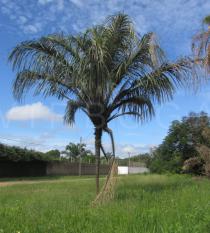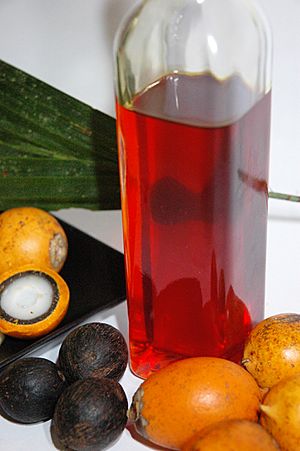Astrocaryum aculeatum facts for kids
Quick facts for kids Astrocaryum aculeatum |
|
|---|---|
 |
|
| Scientific classification | |
| Genus: |
Astrocaryum
|
| Species: |
aculeatum
|
| Synonyms | |
|
Astrocaryum tucuma Mart. |
|
The Astrocaryum aculeatum is a type of palm tree. It's known by many names in Brazilian Portuguese, like tucumã. This palm tree grows in warm, tropical parts of South America and on the island of Trinidad. It can grow quite tall, up to 15 meters (about 49 feet)! Usually, you'll find these trees growing by themselves, not in big groups. They have leaves that point upwards, and their flowers grow straight up too. The fruit they produce is bright yellow.
Contents
What's in a Name?
The name tucumã comes from the word tuku'mã. This word is from the Tupi language, which is spoken by some native people in Brazil.
How it was Discovered
The Astrocaryum aculeatum was first described by a German botanist named Georg Friedrich Wilhelm Meyer. He wrote about it in 1818. He found a sample of the plant near the Essequibo River in Guyana.
Where it Grows
You can find the Astrocaryum aculeatum palm tree in and around the Amazon Basin. This huge area includes many countries. It grows from Trinidad and Tobago in the north. Then it spreads through Venezuela, Guyana, and Suriname. You can also find it in many parts of Brazil, like Acre and Amazonas. It also grows south into parts of Bolivia, such as Beni and Santa Cruz.
How People Use It
This amazing palm tree has many uses!
- Its fruit can be eaten. People sometimes use it to make a special kind of wine.
- A special ring called a tucum ring is made from this tree. It's a symbolic ring, meaning it has a special meaning for people.
- People also get strong fibers from the leaves. These fibers are used to make things like hammocks and ropes. The ropes are very strong and can even resist salt water!
Tucumã Oil
The fruit of the tucumã has a hard, dark, woody center. Inside this center is a white, soft part, often called an "almond" in Brazil. The outside of the fruit is covered with a yellow-orange pulp. People can get two different kinds of oil from this fruit. One oil comes from the outer pulp, and the other comes from the "almond" inside.
The oil from the pulp has different types of fats. About 25.6% are saturated fats, and 74.4% are unsaturated fats. These fats include things like oleic and linoleic acids. This oil can be used to make skin soft and smooth, like a moisturizer. It also has a lot of beta-carotene, which is good for you. The oil has even more beta-carotene than the fruit pulp itself!
In Beauty Products
In the future, the oil from the tucumã pulp might be used in many beauty products. It could be used to make soap, lotions for your body, or products for hair care. This shows how useful this palm tree can be!
See also
 In Spanish: Cumare o tucumá para niños
In Spanish: Cumare o tucumá para niños


